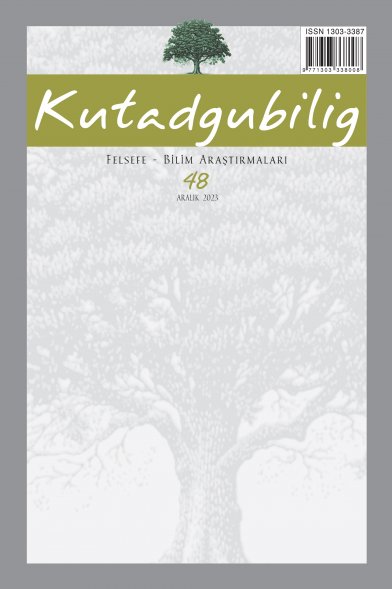CANLILIK VE CANLILIKBİLİMİ ÜZERİNE YENİ BİR DEĞERLENDİRME
A NEW CONSIDERATION ON LIFE AND LIFE-SCIENCE
___
Aranda Anzaldo, Armando; “Back to the Future: Aristotle and Molecular Biology” Ludus Vitalis, 2007, XV:28 195-198.Aristoteles; Fizik, çev.: Saffet Babür, Yapı Kredi Yayınları, İstanbul, 2017, 6. Baskı
Aristoteles; Metafizik, çev.: Y. Gurur Sev, Pinhan Yayıncılık, İstanbul, 2018, 4. Baskı
Chamovitz, Daniel; Bitkilerin Bildikleri: Dünyaya Bitkilerin Gözünden Bakmak, çev.: Gürol Koca, Metis Yayınları, İstanbul, 2018.
DesJardins, Joseph R.; Çevre Etiği-Çevre Felsefesine Giriş, çev.: Ruşen Keleş, İmge Kitabevi, İstanbul, 2006.
Dupré, John; –Nicholson, Daniel J.; A Manifesto for a Processual Philosophy of Biology. (In: Daniel J. Nicholson-John Dupré 2018. Everything Flows Towards a Processual Philosophy of Biology). Oxford University Press, 2018, 3-45.
Herring, Emily;-Radick, Gregory; Emergence in Biology: From Organicism to Systems Biology. In: The Routledge Handbook of Emergence (Eds. Sophie Gibb, Robin Findlay Hendry, Tom Lancaster), 2019, s. 352-362.
Jones, Owen D.; Proprioception, Non-Law, And Biolegal History, Florida Law Review. 53(5), 2001:831-874.
Kaya, İnci Başak;-Yardımcı, Hakan; Quorum Sensing. Etlik Vet Mikrobiyol Derg, 25 (1), 2014: 25-31
Koffka, Kurt; Principles of Gestalt Psychology. Harcourt, Brace and Company, New York, 1935, s. 177-176.
Lewontin, Richard Charles; İdeoloji Olarak Biyoloji-DNA Doktrini, çev. Cengiz Adanur, Kolektif Kitap, İstanbul, 2015.
Macklem, Peter T.; Emergent phenomena and the secrets of life, J Appl Physiol 104, 2008, 1844–1846. doi:10.1152/japplphysiol.00942.2007.
Mancuso, Stefano;-Viola, Alessandra; Bitki Zekası: Bitki Zekasının Şaşırtıcı Tarihi ve Bilimi, Yeni İnsan Yayınevi, 2017.
Mayr, Ernst; What Makes Biology Unique?, Considerations on the Autonomy of a Scientific Discipline. Cambridge University Press, 2004, 21-38.ISBN-13 978-0-521-84114-6.
Monod, Jacques; Rastlantı ve Zorunluluk: Modern Biyolojinin Doğa Felsefesi, Alfa Yayıncılık, 2012, s. 23-30.
Popa, Radu; Between Necessity and Probability: Searching for the Definition and Origin of Life, Berlin Heidelberg, Springer-Verlag, ISBN: 978-3-540-20490-9, 2004, 197-205.
Pross, Addy; Yaşam Nedir? Kimyanın Biyolojiye Dönüşümü, çev.: Raşit Gürdilek, Metis Yayınları, İstanbul, 2016, 1. Baskı, 2016.
Schleiden, Matthias Jakob; Beiträge zur Phytogenesis. Arch. Anat. Physiol. Wiss. Med. 13, 1838, 137-176.
Schwann, Theodor; Mikroskopische Untersuchungen über die Übereinstimmung in der Struktur und dem Wachstum der Tiere und Pflanzen. Sander’schen Buchhandlung, Berlin, 1839, 191-257.
Simons, Peter; Processes and Precipitates (In: Daniel J. Nicholson, John Dupré 2018. Everything Flows Towards a Processual Philosophy of Biology), Oxford University Press, 2018, s. 49-60.
Spencer, Herbert; The Principles of Biology, Vol I., D. Appleton and Company, New York, 1884, 462-463.
Thamrin, Cindy;-Frey, Urs; Complexity and respiratory growth: a developing story. J Appl Physiol 106, 2009, 753–754. doi:10.1152/japplphysiol.91588.2008.
Tulving, Endel; How Many Memory Systems Are There?, American Psychologist, Vol. 40, No. 4, 1985, 385-398.
Virchow, Rudolf; One hundred years of general pathology. In: Diseases, Life, and Man: Selected Essays by Rudolf Virchow, trans. Lelland J. Rather, Stanford, CA, Stanford University Press, 1958, 170–215.
von Bertalanffy, Karl Ludwig; General System Theory: Foundations, Development, Applications, Revised Ed. New York: Braziller, 1968.
Yılmaz, Özlem; Aristoteles’in Dört Neden Kuramının Günümüz Biyolojisi Açısından Önemi, FLSF (Felsefe ve Sosyal Bilimler Dergisi), 16, 2013: 221-230.
- ISSN: 1303-3387
- Yayın Aralığı: 2
- Başlangıç: 2002
- Yayıncı: Dergah Yayınları A.Ş.
EPİKUROS’UN AHLÂK FELSEFESİNDE MUTLULUK KAVRAMI
GENEL İLE ÖZEL ARASINDA OSMANLI TASNÎFU’L-ULÛM LITERATÜRÜNE GİRİŞ
UYGUR MANİHAİZMİ’NDE RUHLARIN KURTULUŞUNA AÇILAN KAPILAR: İKİ IŞIK SARAYI
DESCARTES’IN DOĞA FELSEFESİNİN MADDE KAVRAYIŞI
ELİTİST FELSEFE VE EZOTERİK DİKTATÖRLÜK: LEO STRAUSS ÖZELİNDE BİR TARTIŞMA
ADALET, SİYASET VE İYİ YÖNETİM: LİBERALİZMİN SÖYLEMSEL TAHAKKÜMÜNE BİR İTİRAZ
CANLILIK VE CANLILIKBİLİMİ ÜZERİNE YENİ BİR DEĞERLENDİRME
ARİSTOTELES VE DESCARTES: METAFİZİK, BİLİM VE TEKNİK ARASINDAKİ İLİŞKİNİN DÖNÜŞÜMÜ
